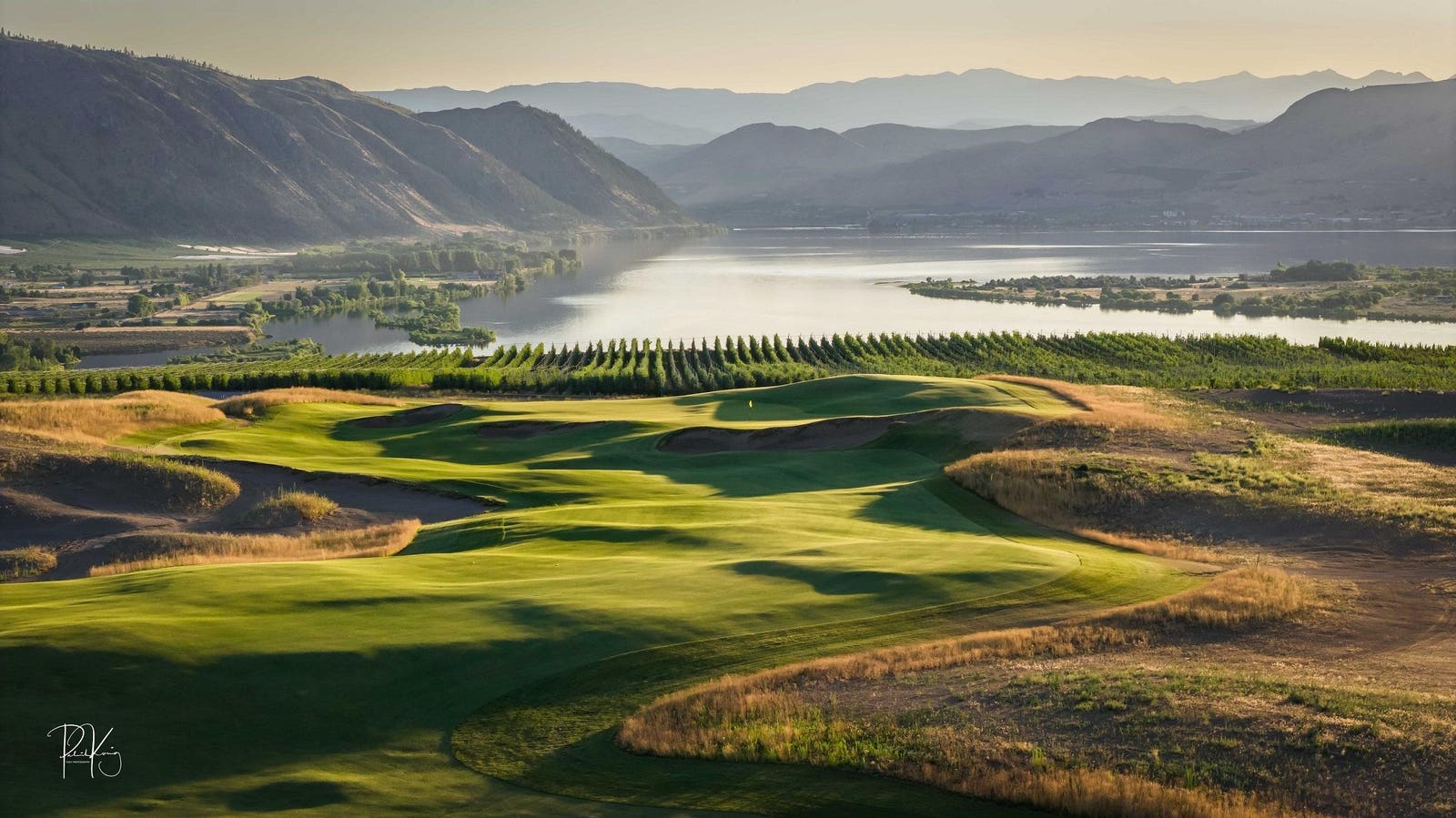
An aerial of Scarecrow, the newest course designed by David McLay Kidd at the Gamble Sands Resort in Eastern Washington.
Patrick Koenig | Troon
With Gamble Sands Resort officially opening its second championship course – Scarecrow — in the high desert of Eastern Washington, let the debate begin. Which is the better course?
It’s a good problem to have and one that’s seemingly inevitable at popular destination golf properties like Bandon Dunes, Sand Valley, Streamsong, Pebble Beach, and Whistling Straits.
And the debut of Scarecrow unquestionably transforms Gamble Sands from what was primarily a regional escape into one of America’s most compelling national golf getaways. As Mike Keiser is famous for saying — one course is a curiosity while two make a destination. Perhaps nobody knows that better than Keiser, the founder of Bandon Dunes, the remote golf-only resort on the Oregon coast that ushered in the build-it-right-and-they-will-come movement for off the beaten path golf destinations.
The Gebbers family has followed that blueprint with Gamble Sands, turning again to architect David McLay Kidd – the designer of the very first course at Bandon Dunes – to create their second course on former cornfields high above the Columbia River Valley. While the corn is gone, the Scarecrow remains, and the new course is both a complement and contrast to the original Sands course.
The 11th green at Scarecrow (foreground), with the Inn and Cascades putting course, and the original Sands course at Gamble Sands in the background.
Erik Matuszewski
McLay Kidd is certain about one thing when it comes to Scarecrow: it occupies the more compelling landscape.
McLay Kidd knew the terrain was more dynamic the first time he walked the property more than 15 years ago – with rumpled landforms, a river-view ridgeline, and rolling dunes where the routing would start and finish. The problem was power lines that cut through the middle of the site, with the prospect of a costly removal project leading the owners and McLay Kidd to first build the Sands course on an adjoining piece of rolling land with equally stunning views.
Once Gamble Sands became a success – it’s soared to No. 31 in Golf Digest’s ranking of America’s 100 greatest public courses – the relocation of the power lines (at a cost of around $250,000) went from aspirational to a reality. And so did Scarecrow.
A Vision Realized
The new Scarecrow course at Gamble Sands sits on more dynamic terrain than the original course, which is ranked in national Top 100 lists.
Erik Matuszewski
Where the original Sands Course sprawls across the landscape with massive fairways and expansive greens, Scarecrow is more intimate and strategic – traveling golfers will find a shot-maker’s test that makes full use of the property’s natural elevation changes and dramatic topography.
While the courses are siblings, McLay Kidd describes Scarecrow as the “twisted sister.”
“We wanted to offer the golfer a different experience than the first course but not so different as to be alien,” said McLay Kidd, who leaned heavily on design associate and shaper Nick Schaan. “We respected the players’ love of fescue, the wide fairways and most especially the fun factor, but we added a little spice.”
One of the punchbowl greens at Scarecrow, with the new housing component at Gamble Sands overlooking the course to the right.
Erik Matuszewski
Overlooking not only the river but the neighboring Gebbers’ family apple and cherry orchards, the heaving ridges and rugged gulches at Scarecrow lend themselves to speed slots, blind shots, punchbowl greens, and holes that boomerang around or play over massive waste areas.
There are angles, slopes and a wonderful mix of holes, from an opening par 4 that plunges downhill to a green tucked into a grassy dell to the closing risk-reward par 4 that plays over a deep sandy wash to a well-protected green benched along a cliff.
There are sweeping views throughout the routing, the highlight of which might be the 9th, 10th, and 11th holes that offer stop-in-your-tracks looks at the river and mountains in the distance. Two of those holes are short par 3’s, including the 11th that plays to a picturesque green squeezed onto a peninsula ridge that’s in view from the Inn at Gamble Sands and its Cascades putting course. Schaan said the team had thought about that site as a golf hole for years, as had many imaginative visitors whose eyes are inescapably drawn in that direction as they stood on the back deck of their rooms.
“The green sits in a saddle that might be the coolest spot on the property because you see both stretches of the river — and in the span of 150 yards, they both disappear and reappear at least once,” said Schaan.
The 10th, meanwhile, is a strong contender for the finest hole on the entire property, a par 4 that swoops downhill toward the river with a halfway house positioned to capture the magnificent vistas.
A Single Architect
Scarecrow is the third course at Gamble Sands designed by architect David McLay Kidd, who 26 years ago created the first course at Bandon Dunes Golf Resort.
Erik Matuszewski
In an era when most destination properties mix and match architects, Gamble Sands has stayed true to a single vision with McLay Kidd and his team.
The result is a golf experience that feels both cohesive and refreshingly varied — as the Sands and Scarecrow each have their own distinct personality. McLay Kidd also designed Quicksands, the fun-filled 14-hole par-3 course that has become a favorite for groups looking to extend their golf day or settle wagers, as well as what might be the finest putting course in the world of destination golf. Cascades is a 100,000-square-foot roller coaster of a layout that stretches across 175 yards of rolling fescue behind the rooms at the inn.
With Scarecrow’s opening, Gamble Sands firmly puts itself in the realm of America’s premier golf destinations. The resort now offers 50 holes of championship golf, expanded accommodations totaling 77 luxury rooms, and locally inspired dining options that include Danny Boy Bar & Grill and The Barn restaurant.
Both 18-hole courses at Gamble Sands overlook the Columbia River Valley.
Erik Matuszewski
There’s an unmistakable sense of space at Gamble Sands, which is in the middle of Washington’s agricultural heartland, about four hours from Seattle and two hours from Spokane. As other bucket-list destination properties face waitlists of a year or more amid record levels of U.S. golf travel, the opening of Scarecrow has further grabbed the attention of itinerant golfers eager to experience a pure golf getaway in a uniquely picturesque region of the Pacific Northwest.
And now, part of that pilgrimage is debating which golf course is better.







